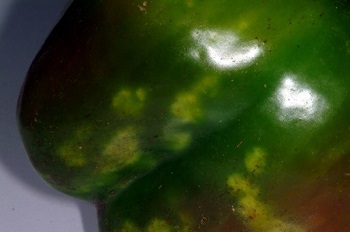Brown Marmorated Stinkbug in the Home Garden
ENTFACT-326: Brown Marmorated Stinkbug in the Home Garden | Download PDF
Jessica Cole, Extension Associate, and Ric Bessin, Extension Specialist
University of Kentucky College of Agriculture
Brown marmorated stink bug (BMSB), Halyomorpha halys, is a new invasive species from Asia. First detected in Kentucky in 2010 it can now be found in multiple eastern and central Kentucky counties. BMSB is very mobile in the landscape and a serious pest that has a wide range of host plants, including significant agricultural and horticultural crops. BMSB aggregates in large numbers when feeding and can do significant damage to high-value crops. BMSB generally attacks the fruiting parts of plants, but it will also feed on other succulent parts, and the nymphs feed on leaves. In the fall the BMSB becomes a nuisance pest (like the Asian lady beetle) by migrating to homes and other buildings to overwinter. The last two weeks of September through the first two weeks of October is when high numbers of BMSB start coming into homes. When disturbed the BMSB will release a pungent odor that smells like cilantro.
Identification
BMSB have the characteristic “shield” shape like all stink bugs. Adult BMSB are 14-17mm (5/8 inch) long, which makes them one of the larger stink bugs in Kentucky. They are a mottled brownish-grey color and have smooth shoulder margins without any toothed edges. BMSB has two distinct white bands on its otherwise dark antennae. The edge of the abdomen beyond the wings also has this alternating dark and light banding. The underside of the BMSB is white with some dark markings.

BMSB adult (right) and late instar nymph (left).
Biology
From June to August females lay clusters of 25-30 light green barrel-shaped eggs on the undersides of leaves. Nymphs go through five different instars (stages) to reach adulthood while feeding throughout the summer and fall. The nymphs are brightly colored red and black that look like a smaller version of the adult stink bug. Older nymphs are a darker color with banding on their antenna and legs, similar to the adults. Based on published growth models, there should be one to two generations per year depending on the location in the state the summer temperatures.
Damage
BMSB is notable for having a wide range of hosts, over 100 plant species, including vegetable crops, grain crops, fruit crops and ornamental crops. Like other species of stink bugs both nymphs and adults use their piercing-sucking mouth parts to feed on leaf and fruit tissue. BMSB feeding can result in small discolored or necrotic areas on leaves and various types of damage to fruit. Fruit damage may include water-soaked legions or cat-facing ranging from mild to severe. When feeding the BMSB aggregate in large numbers resulting more damage than our native stinkbug species.

Stink bug damage to peppers

Internal damage to apple
Home Invasion
The BMSB is not only a serious agricultural pest but it is a major nuisance pest to homeowners. As fall approaches, adult stink bugs leave their feeding sites in search of a place to overwinter. Unfortunately, they frequently select homes. From the end of September through October, BMSB will start entering homes, buildings, or other structures. Male BMSB release a pheromone that attracts other BMSB to the location. Large numbers of BMSB will aggregate together in homes and when disturbed will produce a foul odor. Fortunately they pose no threat to human or animal health inside the home.
Management
Management tools for this new invasive pest are still being developed both for use in commercial agriculture and for the home gardener. Research in other states has shown that BMSB moves from one crop to another in the landscape and is considered highly mobile. Field populations start to build in May and peak in early August. By mid-September they begin moving to buildings to seek winter shelter.
Netting
Woven row covers and fine netting can be used to keep BMSB off of highly susceptible vegetable plants like peppers and tomatoes. These need to be in place prior to the start of fruiting and should be sealed along the edge to keep BMSB out. Research at U.K. Entomology has found that 1/6” or smaller netting will block BMSB adults. A simple frame can be used to support the netting over taller vegetable plants. Netting may not be practical for plants that are dependent on constant insect pollination.
Hand Picking
While impractical with large pest populations, hand-picking can be very helpful with small numbers of pests. BMSB has a tendency to drop off plants when approached, so hand picking may be easier in the morning when the insects are more sluggish. Stink bugs that are collected can be dropped into soapy water. As BMSB is mobile, re-infestation from other areas is likely, so routine hand-picking may be necessary.
Chemical Control
With home gardening, chemical control is usually the last resort. Chemical control has a number of potential side-effects, including limiting when you can harvest produce and impact on pollinators and other beneficial insects. Specific insecticides will depend on the type of plant needing treatment. The crop plant must be approved and listed on the label with the appropriate rate. Research has demonstrated that products containing some of the pyrethroid insecticides (eg., bifenthrin, zeta-cypermethrin, and cyfluthrin) and organophosphate (malathion) can be effective against BMSB. Since these products can be detrimental to insect pollinators, they should not be used on plants in bloom or used in the evening when pollinators are not active.
12/2015
